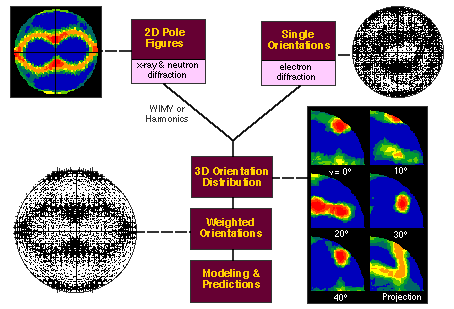Preferred Orientation Package - Los Alamos
Albeit out-dated by now, the Preferred Orientation Package - Los Alamos (popLA) package still offers functionality in demand by the texture community. Please note that the development of the core package stopped in 1994. This means the software may require emulators such as VirtualBox to run on a given system.
There is a python based GUI version of popLA under development and this version is also available upon request.
We encourage researchers interested in popLA to also look at the following much more modern packages for texture analysis to see if they fit their needs:
Potential users of popLA may also be interested in the capabilities of the HIPPO neutron diffractometer for bulk texture measurements at ambient and non-ambient conditions. Please contact Sven Vogel to discuss possible collaborations.
The popLA (preferred orientation package - Los Alamos) texture analysis software package, developed at Los Alamos by Fred Kocks and collaborators, provides a comprehensive treatment of material texture analysis by reducing, visualizing and discretizing texture data in a flexible format. The distribution of crystal orientation, or texture, in polycrystalline materials is calculated and displayed by a wide variety of graphic formats for comparison with published results. Once distributions have been determined, standard methods can be used to predict mechanical properties employed by industry to design and control efficient metals and ceramics processing techniques.
popLA is a set of MS-DOS computer programs that help analyze textures in materials. It is designed as a coherent package, but individual programs may be used separately. Compatibility with other packages is achieved through various conversion programs.
popLA is primarily designed to evaluate pole figures generated by 4-circle goniometer X-ray diffraction equipment but can also be used with pole figures generated from other sources (e.g. neutron or electron diffraction). popLA's data analysis programs correct pole figure data for background X-ray counts, the drop in measured intensity which occurs at the edge of the sample due to geometric considerations, and sample misalignment. Two types of analyses, the harmonic method and the WIMV method, may be used to calculate the orientation distribution of the sample. Pole figures and orientation distributions determined by popLA may be displayed for screen capture.
popLA only available for PC-based platforms
These two papers describe popLA in more detail:
- Kallend et al., Operational texture analysis, Materials Science and Engineering: A, Volume 132, February 1991, Pages 1–11.
- Kallend et al., popLA - An Integrated Software System for Texture Analysis, Textures and Microstructures, Volume 14 (1991)–18.
popLA
- Reduction of raw data from X-ray, neutron, or electron diffraction techniques
- Graphical representation of textures in a flexible format
- Discrete texture representations through a weighted set of orientations; provides interface between experimental textures and other simulation codes
- Anisotropic property predictions, including average elastic constants and r-values
- Serves as a research tool for investigating microstructure/property relationships
The primary developer of popLA was Fred Kocks, Fellow and Technical Staff Member (retired)at Los Alamos National Laboratory.
popLA information
As a derivative product of the United States government and its contractors, popLA is distributed in accordance with guidelines and regulations from the US Department of State and Department of Commerce. popLA has been determined to be 'fully released' software (LA-CC-89-18) and can be downloaded using the links in the right sidebar on this page.
popLA outline
Data from three scattering techniques (x-ray, neutron, and electron diffraction) can be used by popLA to determine a three-dimensional orientation distribution through WIMV (named for the authors of the technique) or harmonics reduction methods. The 3-D orientation can then be used to generate a representative set of weighted orientations.
The weighed orientations can serve as input to any secondary deformation simulation code.



